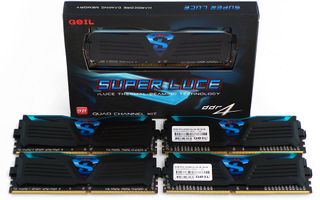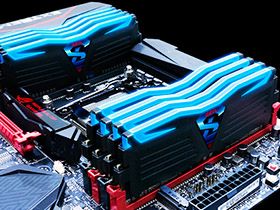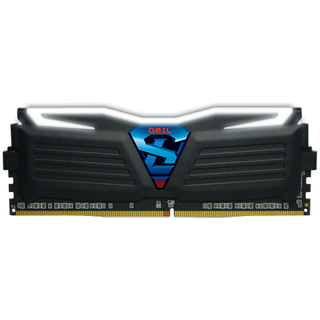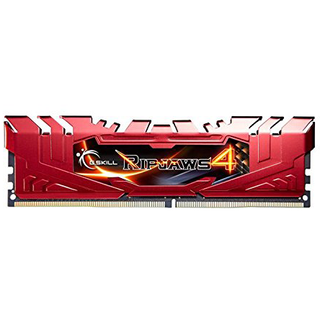Early Verdict
Geil’s Super Luce DDR4-3400 is a flashy and overclockable alternative to traditional DDR4-3000, even if it never reaches its rated data rate. We can only recommend it as a toy for tuning fanatics.
Pros
- +
Lighted heat spreaders indicate thermal condition while adding flash to Geil’s Super Luce DDR4-3400.
Cons
- -
We faced extreme difficulties getting Geil’s Super Luce DDR4-3400 to run at its rated settings, and never achieved complete stability at those settings.
Why you can trust Tom's Hardware
Introduction
Golden Emperor International Limited has been producing high-quality modules from custom-sorted DRAM ICs for as long as Tom’s Hardware has been writing reviews. The company hasn't received as much exposure over the last two years, though. Maybe it was waiting for the next big thing, or maybe some of its competitors were getting dibs on the best chips. Regardless of the reason, we were certainly happy when one of Geil's reps told us that it was ready for a triumphant return.

Yes, we did say triumphant. We really can’t think of anything that makes a bigger statement than supplying the fastest memory we’ve ever seen, in the latest format, at better-than-competitive timings and a middle-of-the-road price. We’re talking DDR4-3400 CAS 16, folks, at $320 for a complete set, with lighting added just to help boost sales with enthusiasts who put looks ahead of performance. The lights even begin to flash slowly as the memory warms, with a peak rate of 200 flashes per minute at 55 °C. With an empty slot between each module, we never got these warm enough to exceed the baseline 13 flashes per minute.

A few readers have complained about high CAS ratings on DDR4, but we think the most vocal critics might have forgotten their fractions. Because that “big number” is measured in cycles, and because cycles at twice the frequency take half the time, DDR4-3400 CAS 16-18-18-36 has the same latency in nanoseconds as DDR3-1700 CAS 8-9-9-18. At least that’s the theory. In practice, variables like advanced timings and memory controller latency can have a big effect on the overall performance picture.

While we’d love to see quickness increase noticeably with bandwidth, we realized long ago that we’ve been stuck around 10ns since DDR-400 and have been fighting for 7ns ever since. At least the overall timings for these modules beat our old DDR3-1600 C9 reference settings.
That is to say, Geil’s DDR4-3400 timings are moderately tight in spite of the product name. The only things fishy here are that the company specifies this data rate for two motherboards and that DDR4-3400 isn’t a workable data rate for a 100MHz base clock. We’ll look into both concerns as we compare three of its rivals.

Corsair's Elite 6500 ATX and Elite 2500 Micro-ATX get accent panel options — removable panels available in wood and aluminum

Alleged Zen 5 'Strix Halo' Mobile APU has more GPU cores than RX 7600 XT or PS5 — features monster RDNA 3.5 GPU with 40 compute units

Grab this cool retro console inspired keyboard for just $83
-
jossrik DDR4 sounds like a lot of trouble to me, I really hope they get all of this settled when it hits mainstream motherboards and CPUs. It may just be me, but it seems like a lot of work for memory and not a lot of payoff. It doesn't even sound fun to play with if you don't have a stable place to start from. I can justify the extra money on the processor for a 6 core with hyperthreading, compared to the 4790K, I can even justify the extra money on the board. But the premium on memory right now just seems like a bad deal. Even the inexpensive DDR4 memory seems way too pricey at this point. I know, prices will come down as it becomes more mainstream. I know, slower memory is more stable right now. It's just that the rest of the stuff is high end, and the high end memory doesn't seem to be able to keep it's hands clean.Reply -
Crashman Reply
What's with all the gloom? I see a $50 price premium on 16GB kits, which is big, but if you already paid $50 more for the board it's probably not a deal breaker. And there are lots of kits that work correctly out of the box, all the way up to DDR4-2666. Add DDR4-3000 if you don't care about the 125 MHz BCLK change and all the CPU changes that go with it (you probably do care about those things, though), so still 2666.15887032 said:DDR4 sounds like a lot of trouble to me, I really hope they get all of this settled when it hits mainstream motherboards and CPUs. It may just be me, but it seems like a lot of work for memory and not a lot of payoff. It doesn't even sound fun to play with if you don't have a stable place to start from. I can justify the extra money on the processor for a 6 core with hyperthreading, compared to the 4790K, I can even justify the extra money on the board. But the premium on memory right now just seems like a bad deal. Even the inexpensive DDR4 memory seems way too pricey at this point. I know, prices will come down as it becomes more mainstream. I know, slower memory is more stable right now. It's just that the rest of the stuff is high end, and the high end memory doesn't seem to be able to keep it's hands clean.
And all major motherboard manufacturers are now optimizing for DDR4-3200 at stock BCLK, so it won't be long before you'll be able to select from 2400, 2666, and 3200 kits that operate normally out of the box. Heck, that's probably possible already, we just haven't received the right 3200 kits yet.
I've no clue why companies are optimizing for 2666 and 3200 but not the middle step, 2933. For some strange reason 10x and 12x multiplier appear to work better than 11x, but I'm not sure if it's a firmware or hardware limit.
So, 2133/2400/2666 for now, no configuration ills, and the dollar difference is small enough to be just a nuisance on such an expensive platform.
-
jossrik Reply15887164 said:
What's with all the gloom? I see a $50 price premium on 16GB kits, which is big, but if you already paid $50 more for the board it's probably not a deal breaker. And there are lots of kits that work correctly out of the box, all the way up to DDR4-2666. Add DDR4-3000 if you don't care about the 125 MHz BCLK change and all the CPU changes that go with it (you probably do care about those things, though), so still 2666.15887032 said:DDR4 sounds like a lot of trouble to me, I really hope they get all of this settled when it hits mainstream motherboards and CPUs. It may just be me, but it seems like a lot of work for memory and not a lot of payoff. It doesn't even sound fun to play with if you don't have a stable place to start from. I can justify the extra money on the processor for a 6 core with hyperthreading, compared to the 4790K, I can even justify the extra money on the board. But the premium on memory right now just seems like a bad deal. Even the inexpensive DDR4 memory seems way too pricey at this point. I know, prices will come down as it becomes more mainstream. I know, slower memory is more stable right now. It's just that the rest of the stuff is high end, and the high end memory doesn't seem to be able to keep it's hands clean.
And all major motherboard manufacturers are now optimizing for DDR4-3200 at stock BCLK, so it won't be long before you'll be able to select from 2400, 2666, and 3200 kits that operate normally out of the box. Heck, that's probably possible already, we just haven't gotten the right 3200 kits yet.
Yeah, there is that. I was looking at them a couple days ago, I think it's just the recent reviews here on Toms. It seems like they're all looking at high end stuff and forgetting that even the fastest RAM doesn't make that much of a difference when it comes down to frames. As far as the premium, I was looking at the 4790K, which is like around 340$ give or take, (I don't have a microcenter anywhere near here), and the 5820K, which is around 380$, if you're all ready in for 340, that extra 40$ isn't so bad. Same with the motherboards, if you're all ready in the high end boards you're looking at 200 - 300 for either 1150 or 2011-v3. Either way you go the price difference isn't that bad percentage wise. You can get 16Gb of pretty decently fast DDR3 for around 100$, and the cheapest DDR4 runs around 150$ for 16Gbs. Ya, it's the same 50$, but being that it's so much cheaper for the DDR3 it seems like it's a bigger deal. You're right though, the future for DDR4 is bright. (forgot my happy meds toNight.) Looking forward to when it becomes mainstream and we can get 32Gbs of maybe 3800 for a decent price. It'll be a few years. I'm still mad I bought my 3Tb HDD for 85$ three years ago, went to get a new one cause I don't trust them much longer than that, and they're still 100$. I'm seriously considering getting an external and just taking the drive out and putting that into my computer. :) -
Crashman Reply
In DRAM, we generally try to find the best value in enthusiast parts, plus the best parts, and push back against the best parts by talking about the best-value enthusiast parts. The middle market hasn't opened up much yet, though. The G.Skill DDR4-3000's used as a reference are probably the closest thing to "enthusiast mainstream" at this point, but maybe we'll see a $250 3200 kit in the near future? We can always keep our fingers crossed.15887195 said:I think it's just the recent reviews here on Toms. It seems like they're all looking at high end stuff and forgetting that even the fastest RAM doesn't make that much of a difference when it comes down to frames.
Since 12x appears to be the highest completely stable multiplier for this platform, we'll probably see a platform update before the mid-market exceeds DDR4-3200.
-
uglyduckling81 Is RAM actually holding us back though? I want to see a comparison of DDR3 RAM vs 4.Reply
I'm all for increasing speeds across the board but is RAM an issue at all right now? -
Aspiring techie On the test results chart comparing the different timings, you made a typo. It should be DDR4, not DDR$. :)Reply -
milkod2001 ReplyIs RAM actually holding us back though? I want to see a comparison of DDR3 RAM vs 4.
I'm all for increasing speeds across the board but is RAM an issue at all right now?
ddr4 is basically currently quite overpriced ddr3 with improved voltage from (1.5 to 1.2 ) which transfer into lower power consumption while in performance making zero difference.
ddr4 makes a sense in portable devices where power consumption matters a lot or in large server farms where it could save $$$ over time. Other than that it is quite unimpressive :( -
Sabishii Hito I tried a couple of these kits a few weeks back, they had terrible compatibility with Asus X99 boards. Even on the Rampage V Extreme, setting XMP resulted in no boot. I don't think I ever got 3400 running even on manual settings like using 125 strap and the 3333 divider, clocked up to 3400. Then again these sticks are Samsung-based, which have less compatibility in my experience than Hynix-based kits. For instance, G.Skill Ripjaws 4 3300 16-16-16 can run no issues at 3400 on my setup.Reply -
Sabishii Hito Not surprised with Geil dropping the MSI Xpower support. to date the only board that passes validation with DDR4-3400 kits is the Gigabyte X99 SOC Champion due to having only 4 DIMM slots and shorter traces to the CPU socket, along with having the extra CPU pins.Reply




